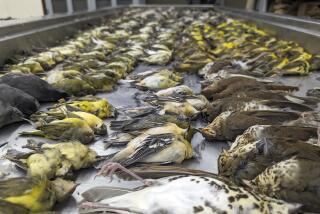Dead Pigeon Snuffs Chance for a Pulitzer
- Share via
This may be a true story. It is not one of those urban myths that always happen to someone’s cousin or sister, but never to anyone you know.
Like an urban myth, this story must be taken on faith; it did not happen to me, but I believe it. It is a newspaper story.
It happened some time ago--last January, a week or two before the Super Bowl game between the Denver Broncos and the Washington Redskins in San Diego.
As it was told to me (by an unimpeachable source), a young reporter from the San Diego edition of The Times went out to Jack Murphy Stadium to see if he could pick up a pregame feature story.
As you know, the Super Bowl gets more media coverage than the Second Coming is likely to, and at least as much as will be accorded to Armageddon. Before the game is played every player is interviewed, the histories of the stars are told, the season is reviewed, the possibilities of the game are debated, over and over again; by the time the kickoff whistle blows the public is glazed and stuffed like a Thanksgiving turkey.
This young man naturally thought that if he could pick up some previously unnoticed angle, it would be a feather in his hat, as indeed it would have been.
He entered the stadium and strolled out on the playing field. Suddenly he became aware of a strange phenomenon. Many dead pigeons lay about on the turf. Too many. It was not natural. Evidently they had died of some pestilence, or they had been murdered.
Being a reporter myself, I can imagine that this reporter’s blood began to rise. He was onto something. Something was amiss here. And he began to believe it must be something sinister.
What occurred to him next must have given him a shock. Was it possible, he thought, that the city of San Diego, hoping to make a good impression on the tens of thousands of visitors expected for the game, and not wanting them to be plagued by clouds of pigeons, had taken precautions to prevent it? Had they, in fact, sprayed the turf with some deadly insecticide?
The young reporter saw an abhorrent picture in his mind. Football players are often ground into the turf, face down. Sometimes, in scrambling for a fumble, they are ground into it for minutes under piles of their fellow players.
What if, he thought, one of them should inhale too much of the insecticide and die? What a scandal that would be. If he could prove that his hunch was correct, he realized, he might even be able to stop the game from being played. What a story! He even allowed himself to think of the Pulitzer Prize.
Furtively he picked up a dead pigeon and stuffed it under his jacket. He took it back to the shop and discussed his discovery with his colleagues. They were excited too. The thing to do, of course, was to find out what had killed the bird. Who could tell them? Checking around town with veterinarians, they learned that a toxicologist in the Middle West was their man.
The reporter took his pigeon home and put it in the freezer overnight and the next day sent it Air Express to the laboratory in the Middle West, Iowa or someplace like that. The next day he got a phone call from the toxicologist. He could not work on a bird that had been frozen. Undismayed, the reporter went back to the stadium and picked up a second dead pigeon and express-mailed it to the laboratory. While waiting for the results, he was drawn back to the stadium to poke around again.
Encountering a caretaker on the playing field, he asked him casually why there were so many dead pigeons about.
“Oh,” the man said. “We heard that dead pigeons would keep other pigeons from coming around. So we bought 40 dead pigeons and scattered them about.”
Our reporter was crushed. His vision of a Pulitzer faded away. He knew what it was like to be a dead pigeon.
I don’t know what killed the pigeons. The autopsy was never performed. But I have an idea they were sold to San Diego by the people who were killing them at Los Angeles City Hall.
More to Read
Go beyond the scoreboard
Get the latest on L.A.'s teams in the daily Sports Report newsletter.
You may occasionally receive promotional content from the Los Angeles Times.










